System Analysis
VerifiedAdded on 2023/06/11
|12
|2624
|394
AI Summary
The report evaluates the identification of three vendors who will suitably serve the purpose of My Health Record system. The report further reviews the cloud based approach that will be suitable for the project. The implementation of the health record project will be following a software development life cycle approach and the report distinguishes whether the choice of predictive or the Adaptive SDLC approach will be suitable to consider.
Contribute Materials
Your contribution can guide someone’s learning journey. Share your
documents today.
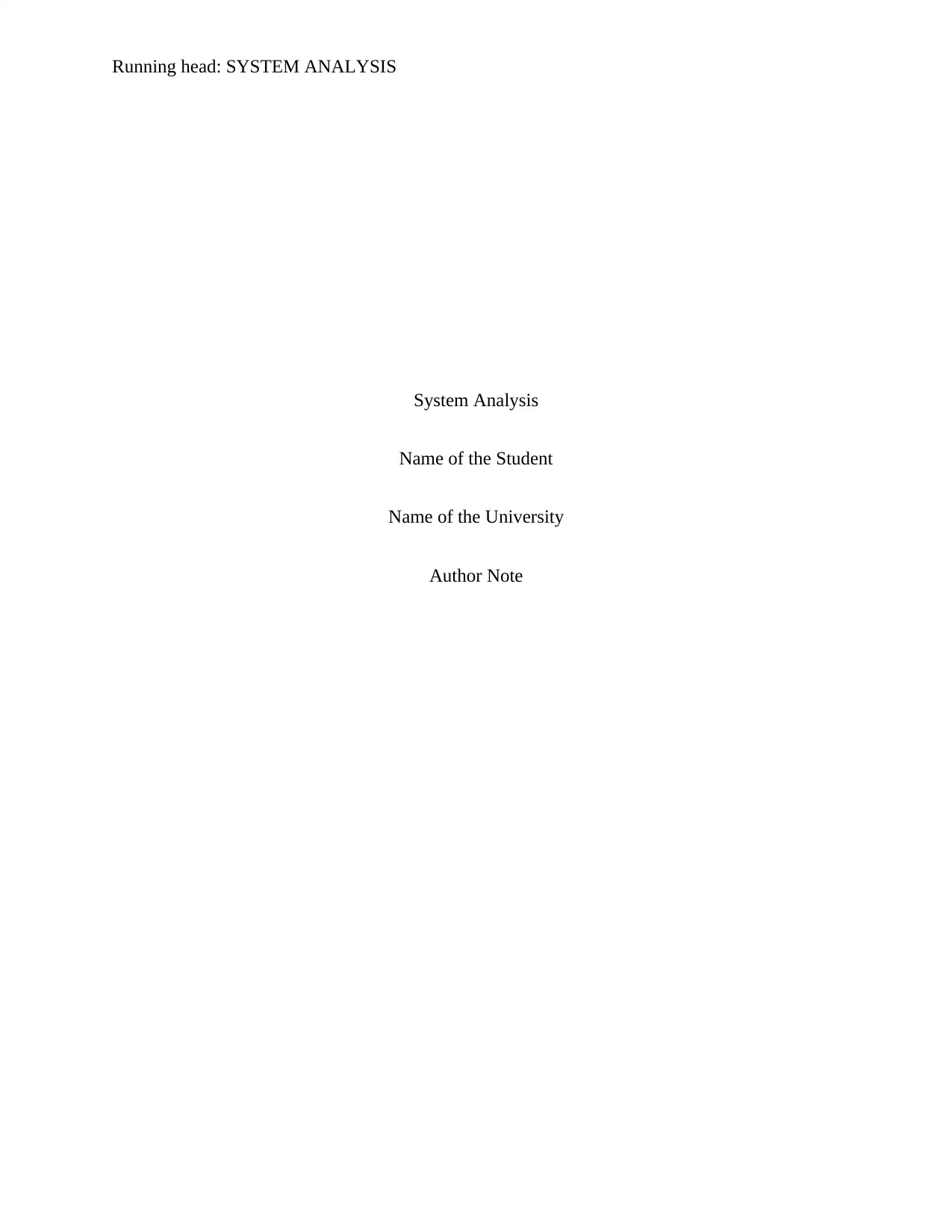
Running head: SYSTEM ANALYSIS
System Analysis
Name of the Student
Name of the University
Author Note
System Analysis
Name of the Student
Name of the University
Author Note
Secure Best Marks with AI Grader
Need help grading? Try our AI Grader for instant feedback on your assignments.
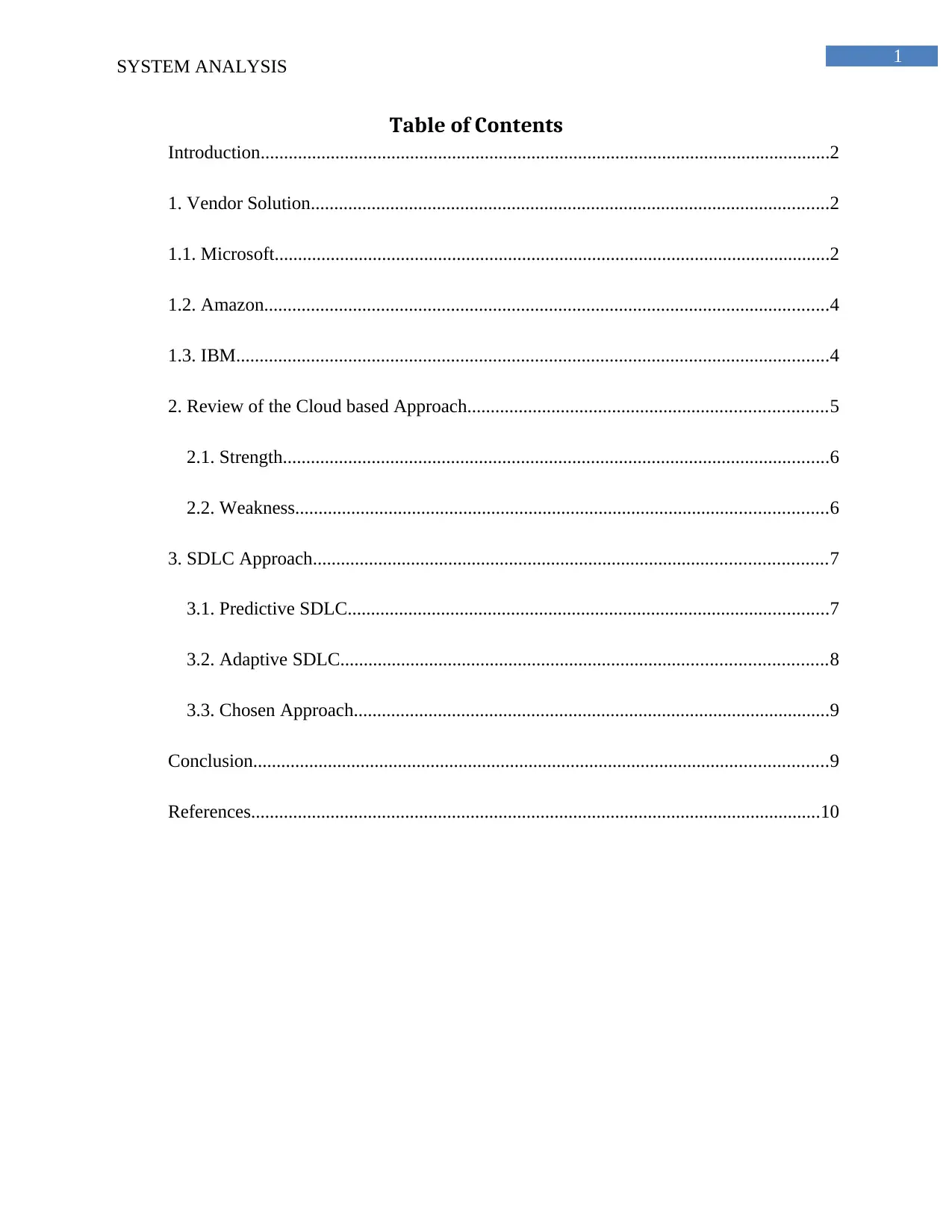
1
SYSTEM ANALYSIS
Table of Contents
Introduction..........................................................................................................................2
1. Vendor Solution...............................................................................................................2
1.1. Microsoft.......................................................................................................................2
1.2. Amazon.........................................................................................................................4
1.3. IBM...............................................................................................................................4
2. Review of the Cloud based Approach.............................................................................5
2.1. Strength.....................................................................................................................6
2.2. Weakness..................................................................................................................6
3. SDLC Approach..............................................................................................................7
3.1. Predictive SDLC.......................................................................................................7
3.2. Adaptive SDLC........................................................................................................8
3.3. Chosen Approach......................................................................................................9
Conclusion...........................................................................................................................9
References..........................................................................................................................10
SYSTEM ANALYSIS
Table of Contents
Introduction..........................................................................................................................2
1. Vendor Solution...............................................................................................................2
1.1. Microsoft.......................................................................................................................2
1.2. Amazon.........................................................................................................................4
1.3. IBM...............................................................................................................................4
2. Review of the Cloud based Approach.............................................................................5
2.1. Strength.....................................................................................................................6
2.2. Weakness..................................................................................................................6
3. SDLC Approach..............................................................................................................7
3.1. Predictive SDLC.......................................................................................................7
3.2. Adaptive SDLC........................................................................................................8
3.3. Chosen Approach......................................................................................................9
Conclusion...........................................................................................................................9
References..........................................................................................................................10
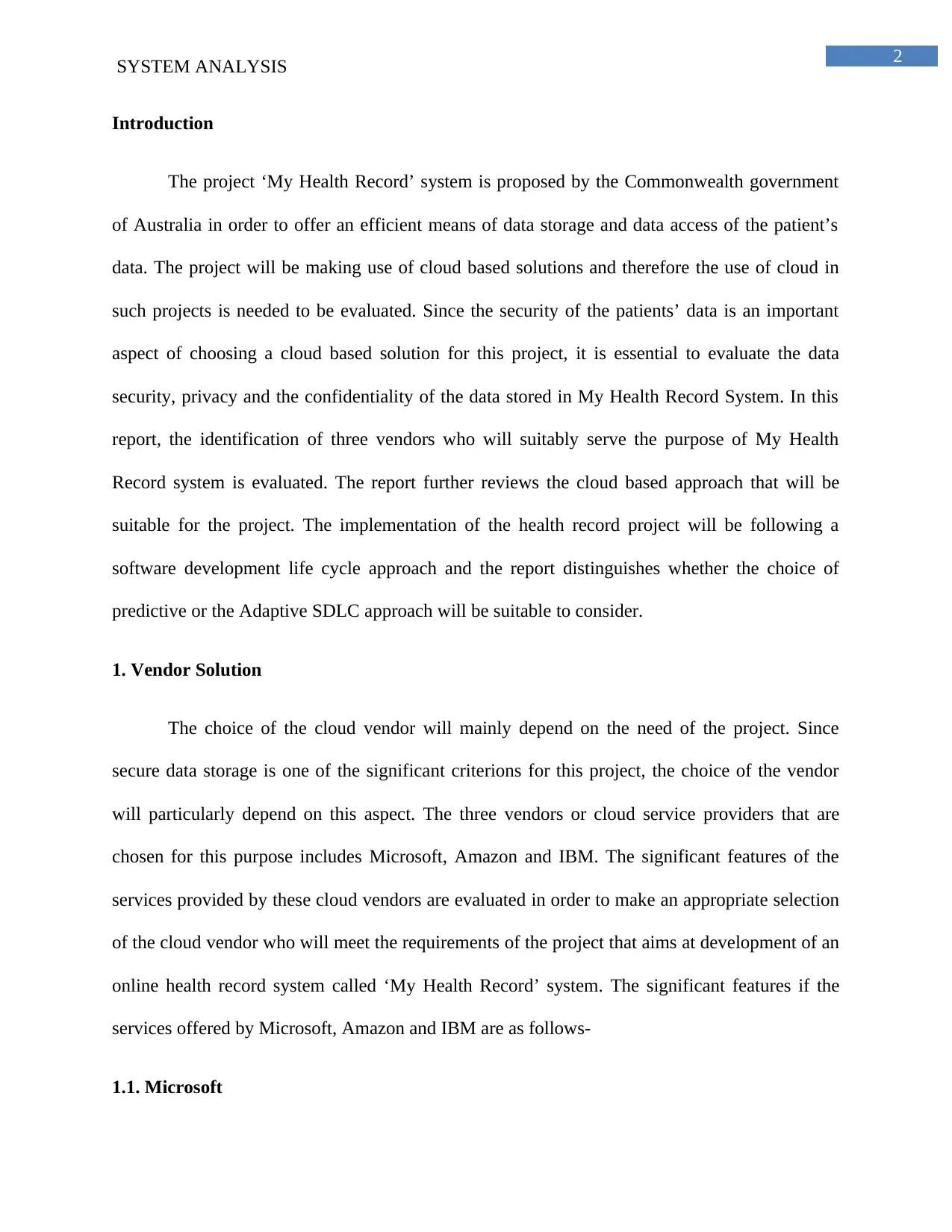
2
SYSTEM ANALYSIS
Introduction
The project ‘My Health Record’ system is proposed by the Commonwealth government
of Australia in order to offer an efficient means of data storage and data access of the patient’s
data. The project will be making use of cloud based solutions and therefore the use of cloud in
such projects is needed to be evaluated. Since the security of the patients’ data is an important
aspect of choosing a cloud based solution for this project, it is essential to evaluate the data
security, privacy and the confidentiality of the data stored in My Health Record System. In this
report, the identification of three vendors who will suitably serve the purpose of My Health
Record system is evaluated. The report further reviews the cloud based approach that will be
suitable for the project. The implementation of the health record project will be following a
software development life cycle approach and the report distinguishes whether the choice of
predictive or the Adaptive SDLC approach will be suitable to consider.
1. Vendor Solution
The choice of the cloud vendor will mainly depend on the need of the project. Since
secure data storage is one of the significant criterions for this project, the choice of the vendor
will particularly depend on this aspect. The three vendors or cloud service providers that are
chosen for this purpose includes Microsoft, Amazon and IBM. The significant features of the
services provided by these cloud vendors are evaluated in order to make an appropriate selection
of the cloud vendor who will meet the requirements of the project that aims at development of an
online health record system called ‘My Health Record’ system. The significant features if the
services offered by Microsoft, Amazon and IBM are as follows-
1.1. Microsoft
SYSTEM ANALYSIS
Introduction
The project ‘My Health Record’ system is proposed by the Commonwealth government
of Australia in order to offer an efficient means of data storage and data access of the patient’s
data. The project will be making use of cloud based solutions and therefore the use of cloud in
such projects is needed to be evaluated. Since the security of the patients’ data is an important
aspect of choosing a cloud based solution for this project, it is essential to evaluate the data
security, privacy and the confidentiality of the data stored in My Health Record System. In this
report, the identification of three vendors who will suitably serve the purpose of My Health
Record system is evaluated. The report further reviews the cloud based approach that will be
suitable for the project. The implementation of the health record project will be following a
software development life cycle approach and the report distinguishes whether the choice of
predictive or the Adaptive SDLC approach will be suitable to consider.
1. Vendor Solution
The choice of the cloud vendor will mainly depend on the need of the project. Since
secure data storage is one of the significant criterions for this project, the choice of the vendor
will particularly depend on this aspect. The three vendors or cloud service providers that are
chosen for this purpose includes Microsoft, Amazon and IBM. The significant features of the
services provided by these cloud vendors are evaluated in order to make an appropriate selection
of the cloud vendor who will meet the requirements of the project that aims at development of an
online health record system called ‘My Health Record’ system. The significant features if the
services offered by Microsoft, Amazon and IBM are as follows-
1.1. Microsoft
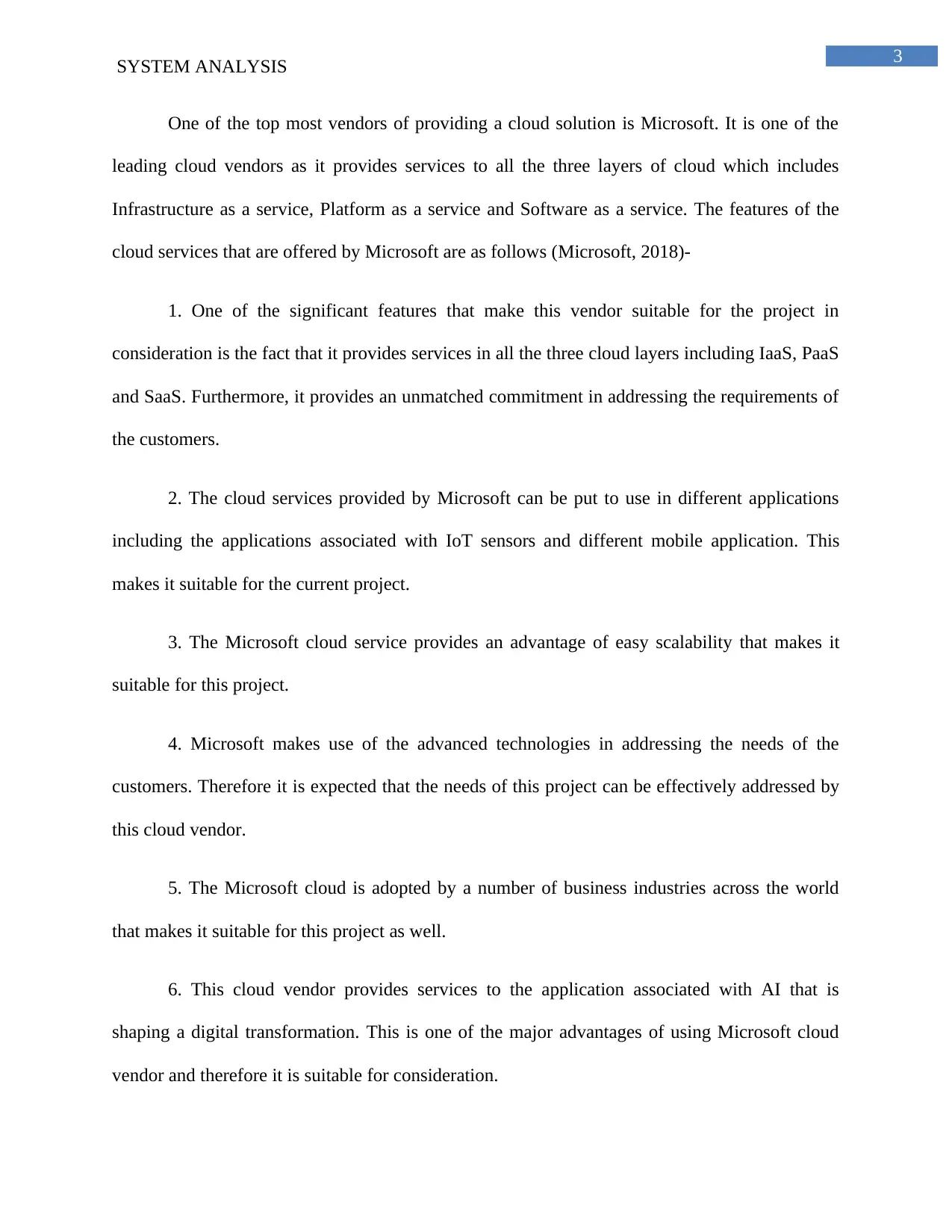
3
SYSTEM ANALYSIS
One of the top most vendors of providing a cloud solution is Microsoft. It is one of the
leading cloud vendors as it provides services to all the three layers of cloud which includes
Infrastructure as a service, Platform as a service and Software as a service. The features of the
cloud services that are offered by Microsoft are as follows (Microsoft, 2018)-
1. One of the significant features that make this vendor suitable for the project in
consideration is the fact that it provides services in all the three cloud layers including IaaS, PaaS
and SaaS. Furthermore, it provides an unmatched commitment in addressing the requirements of
the customers.
2. The cloud services provided by Microsoft can be put to use in different applications
including the applications associated with IoT sensors and different mobile application. This
makes it suitable for the current project.
3. The Microsoft cloud service provides an advantage of easy scalability that makes it
suitable for this project.
4. Microsoft makes use of the advanced technologies in addressing the needs of the
customers. Therefore it is expected that the needs of this project can be effectively addressed by
this cloud vendor.
5. The Microsoft cloud is adopted by a number of business industries across the world
that makes it suitable for this project as well.
6. This cloud vendor provides services to the application associated with AI that is
shaping a digital transformation. This is one of the major advantages of using Microsoft cloud
vendor and therefore it is suitable for consideration.
SYSTEM ANALYSIS
One of the top most vendors of providing a cloud solution is Microsoft. It is one of the
leading cloud vendors as it provides services to all the three layers of cloud which includes
Infrastructure as a service, Platform as a service and Software as a service. The features of the
cloud services that are offered by Microsoft are as follows (Microsoft, 2018)-
1. One of the significant features that make this vendor suitable for the project in
consideration is the fact that it provides services in all the three cloud layers including IaaS, PaaS
and SaaS. Furthermore, it provides an unmatched commitment in addressing the requirements of
the customers.
2. The cloud services provided by Microsoft can be put to use in different applications
including the applications associated with IoT sensors and different mobile application. This
makes it suitable for the current project.
3. The Microsoft cloud service provides an advantage of easy scalability that makes it
suitable for this project.
4. Microsoft makes use of the advanced technologies in addressing the needs of the
customers. Therefore it is expected that the needs of this project can be effectively addressed by
this cloud vendor.
5. The Microsoft cloud is adopted by a number of business industries across the world
that makes it suitable for this project as well.
6. This cloud vendor provides services to the application associated with AI that is
shaping a digital transformation. This is one of the major advantages of using Microsoft cloud
vendor and therefore it is suitable for consideration.
Secure Best Marks with AI Grader
Need help grading? Try our AI Grader for instant feedback on your assignments.
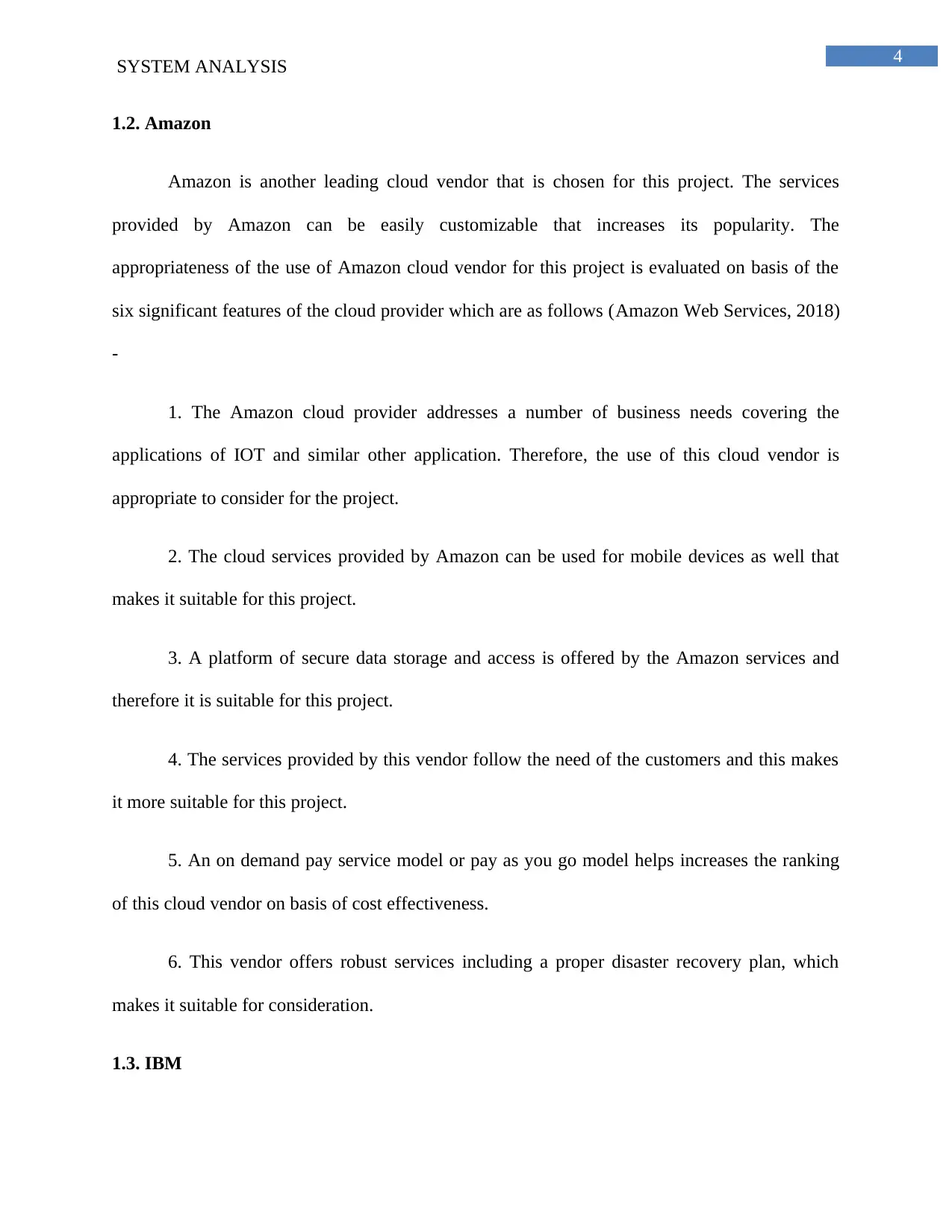
4
SYSTEM ANALYSIS
1.2. Amazon
Amazon is another leading cloud vendor that is chosen for this project. The services
provided by Amazon can be easily customizable that increases its popularity. The
appropriateness of the use of Amazon cloud vendor for this project is evaluated on basis of the
six significant features of the cloud provider which are as follows (Amazon Web Services, 2018)
-
1. The Amazon cloud provider addresses a number of business needs covering the
applications of IOT and similar other application. Therefore, the use of this cloud vendor is
appropriate to consider for the project.
2. The cloud services provided by Amazon can be used for mobile devices as well that
makes it suitable for this project.
3. A platform of secure data storage and access is offered by the Amazon services and
therefore it is suitable for this project.
4. The services provided by this vendor follow the need of the customers and this makes
it more suitable for this project.
5. An on demand pay service model or pay as you go model helps increases the ranking
of this cloud vendor on basis of cost effectiveness.
6. This vendor offers robust services including a proper disaster recovery plan, which
makes it suitable for consideration.
1.3. IBM
SYSTEM ANALYSIS
1.2. Amazon
Amazon is another leading cloud vendor that is chosen for this project. The services
provided by Amazon can be easily customizable that increases its popularity. The
appropriateness of the use of Amazon cloud vendor for this project is evaluated on basis of the
six significant features of the cloud provider which are as follows (Amazon Web Services, 2018)
-
1. The Amazon cloud provider addresses a number of business needs covering the
applications of IOT and similar other application. Therefore, the use of this cloud vendor is
appropriate to consider for the project.
2. The cloud services provided by Amazon can be used for mobile devices as well that
makes it suitable for this project.
3. A platform of secure data storage and access is offered by the Amazon services and
therefore it is suitable for this project.
4. The services provided by this vendor follow the need of the customers and this makes
it more suitable for this project.
5. An on demand pay service model or pay as you go model helps increases the ranking
of this cloud vendor on basis of cost effectiveness.
6. This vendor offers robust services including a proper disaster recovery plan, which
makes it suitable for consideration.
1.3. IBM
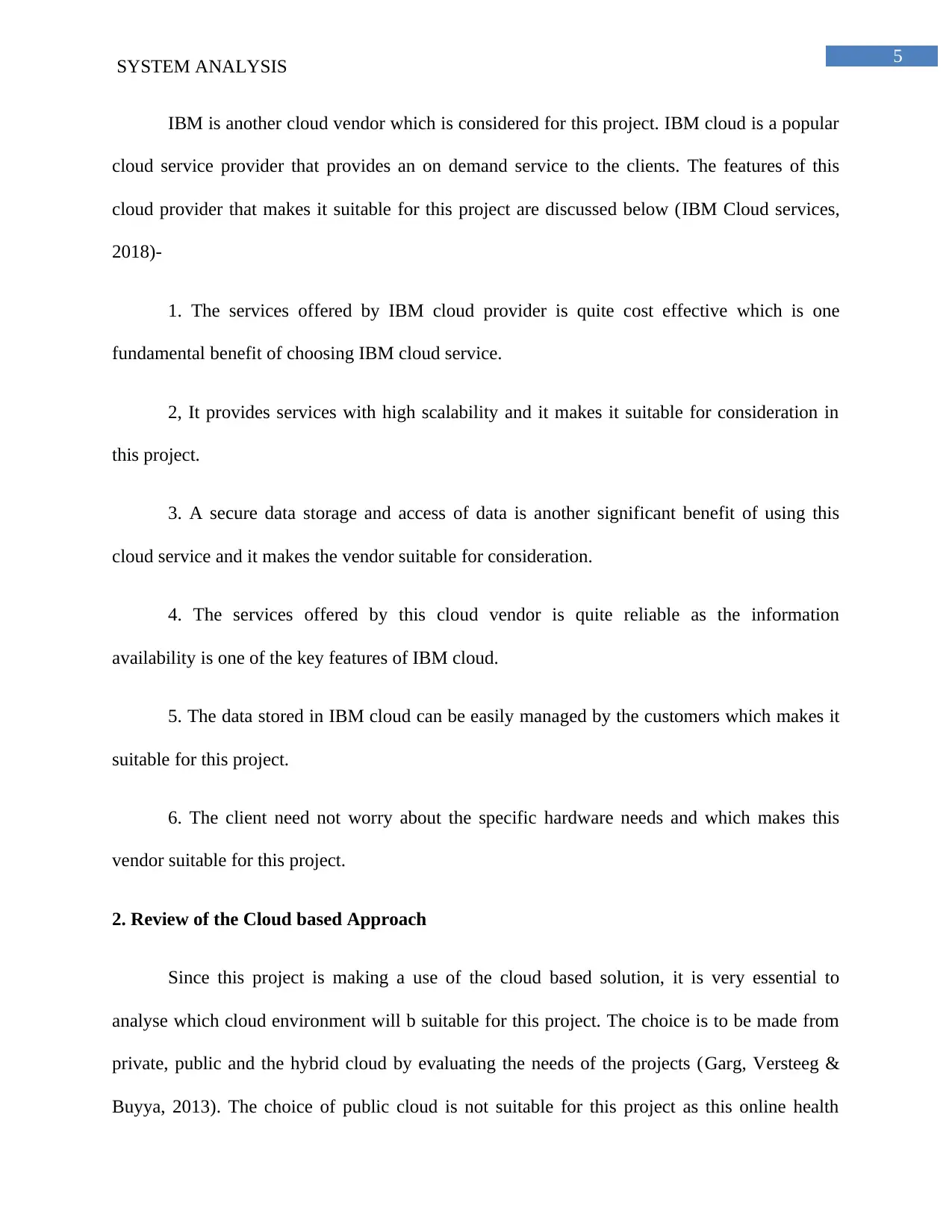
5
SYSTEM ANALYSIS
IBM is another cloud vendor which is considered for this project. IBM cloud is a popular
cloud service provider that provides an on demand service to the clients. The features of this
cloud provider that makes it suitable for this project are discussed below (IBM Cloud services,
2018)-
1. The services offered by IBM cloud provider is quite cost effective which is one
fundamental benefit of choosing IBM cloud service.
2, It provides services with high scalability and it makes it suitable for consideration in
this project.
3. A secure data storage and access of data is another significant benefit of using this
cloud service and it makes the vendor suitable for consideration.
4. The services offered by this cloud vendor is quite reliable as the information
availability is one of the key features of IBM cloud.
5. The data stored in IBM cloud can be easily managed by the customers which makes it
suitable for this project.
6. The client need not worry about the specific hardware needs and which makes this
vendor suitable for this project.
2. Review of the Cloud based Approach
Since this project is making a use of the cloud based solution, it is very essential to
analyse which cloud environment will b suitable for this project. The choice is to be made from
private, public and the hybrid cloud by evaluating the needs of the projects (Garg, Versteeg &
Buyya, 2013). The choice of public cloud is not suitable for this project as this online health
SYSTEM ANALYSIS
IBM is another cloud vendor which is considered for this project. IBM cloud is a popular
cloud service provider that provides an on demand service to the clients. The features of this
cloud provider that makes it suitable for this project are discussed below (IBM Cloud services,
2018)-
1. The services offered by IBM cloud provider is quite cost effective which is one
fundamental benefit of choosing IBM cloud service.
2, It provides services with high scalability and it makes it suitable for consideration in
this project.
3. A secure data storage and access of data is another significant benefit of using this
cloud service and it makes the vendor suitable for consideration.
4. The services offered by this cloud vendor is quite reliable as the information
availability is one of the key features of IBM cloud.
5. The data stored in IBM cloud can be easily managed by the customers which makes it
suitable for this project.
6. The client need not worry about the specific hardware needs and which makes this
vendor suitable for this project.
2. Review of the Cloud based Approach
Since this project is making a use of the cloud based solution, it is very essential to
analyse which cloud environment will b suitable for this project. The choice is to be made from
private, public and the hybrid cloud by evaluating the needs of the projects (Garg, Versteeg &
Buyya, 2013). The choice of public cloud is not suitable for this project as this online health
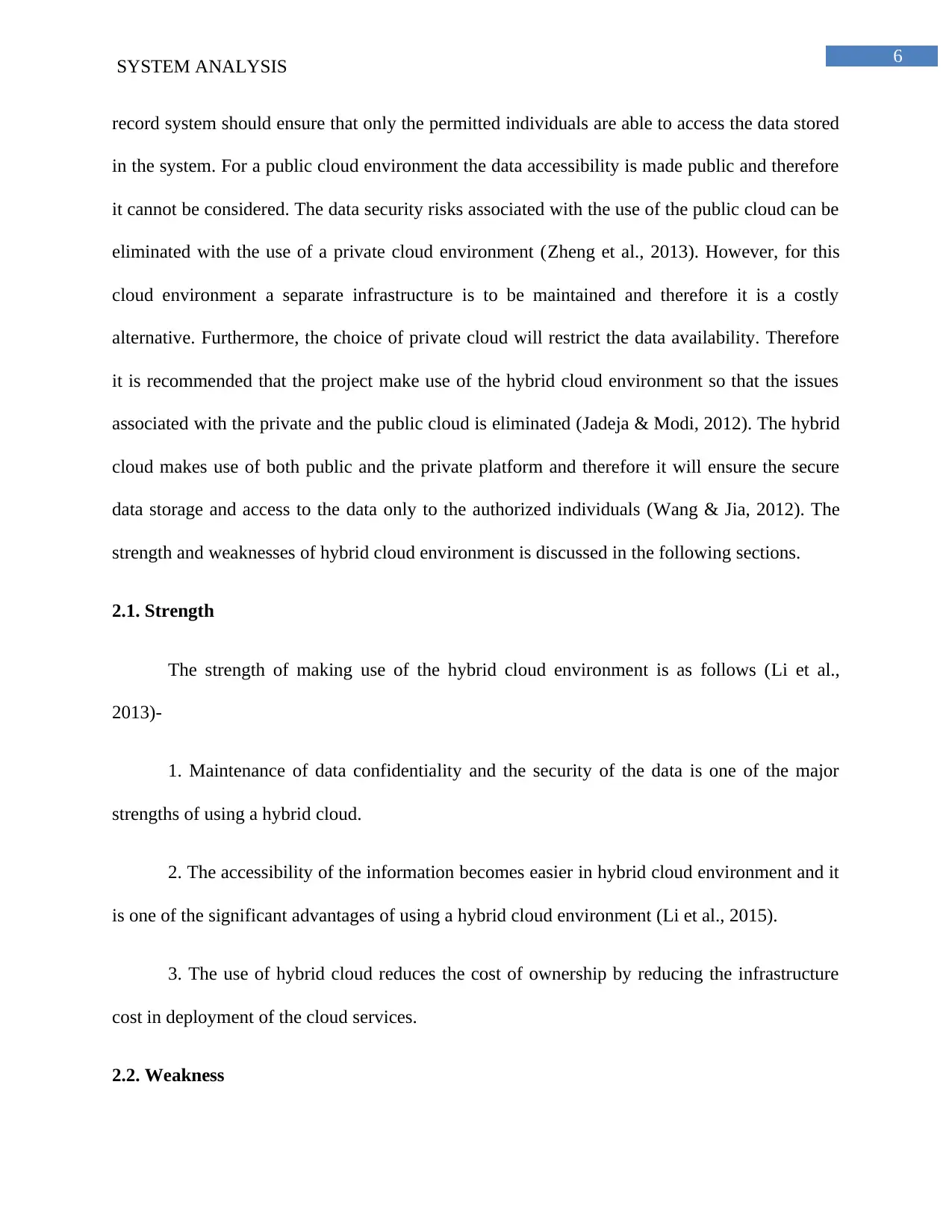
6
SYSTEM ANALYSIS
record system should ensure that only the permitted individuals are able to access the data stored
in the system. For a public cloud environment the data accessibility is made public and therefore
it cannot be considered. The data security risks associated with the use of the public cloud can be
eliminated with the use of a private cloud environment (Zheng et al., 2013). However, for this
cloud environment a separate infrastructure is to be maintained and therefore it is a costly
alternative. Furthermore, the choice of private cloud will restrict the data availability. Therefore
it is recommended that the project make use of the hybrid cloud environment so that the issues
associated with the private and the public cloud is eliminated (Jadeja & Modi, 2012). The hybrid
cloud makes use of both public and the private platform and therefore it will ensure the secure
data storage and access to the data only to the authorized individuals (Wang & Jia, 2012). The
strength and weaknesses of hybrid cloud environment is discussed in the following sections.
2.1. Strength
The strength of making use of the hybrid cloud environment is as follows (Li et al.,
2013)-
1. Maintenance of data confidentiality and the security of the data is one of the major
strengths of using a hybrid cloud.
2. The accessibility of the information becomes easier in hybrid cloud environment and it
is one of the significant advantages of using a hybrid cloud environment (Li et al., 2015).
3. The use of hybrid cloud reduces the cost of ownership by reducing the infrastructure
cost in deployment of the cloud services.
2.2. Weakness
SYSTEM ANALYSIS
record system should ensure that only the permitted individuals are able to access the data stored
in the system. For a public cloud environment the data accessibility is made public and therefore
it cannot be considered. The data security risks associated with the use of the public cloud can be
eliminated with the use of a private cloud environment (Zheng et al., 2013). However, for this
cloud environment a separate infrastructure is to be maintained and therefore it is a costly
alternative. Furthermore, the choice of private cloud will restrict the data availability. Therefore
it is recommended that the project make use of the hybrid cloud environment so that the issues
associated with the private and the public cloud is eliminated (Jadeja & Modi, 2012). The hybrid
cloud makes use of both public and the private platform and therefore it will ensure the secure
data storage and access to the data only to the authorized individuals (Wang & Jia, 2012). The
strength and weaknesses of hybrid cloud environment is discussed in the following sections.
2.1. Strength
The strength of making use of the hybrid cloud environment is as follows (Li et al.,
2013)-
1. Maintenance of data confidentiality and the security of the data is one of the major
strengths of using a hybrid cloud.
2. The accessibility of the information becomes easier in hybrid cloud environment and it
is one of the significant advantages of using a hybrid cloud environment (Li et al., 2015).
3. The use of hybrid cloud reduces the cost of ownership by reducing the infrastructure
cost in deployment of the cloud services.
2.2. Weakness
Paraphrase This Document
Need a fresh take? Get an instant paraphrase of this document with our AI Paraphraser
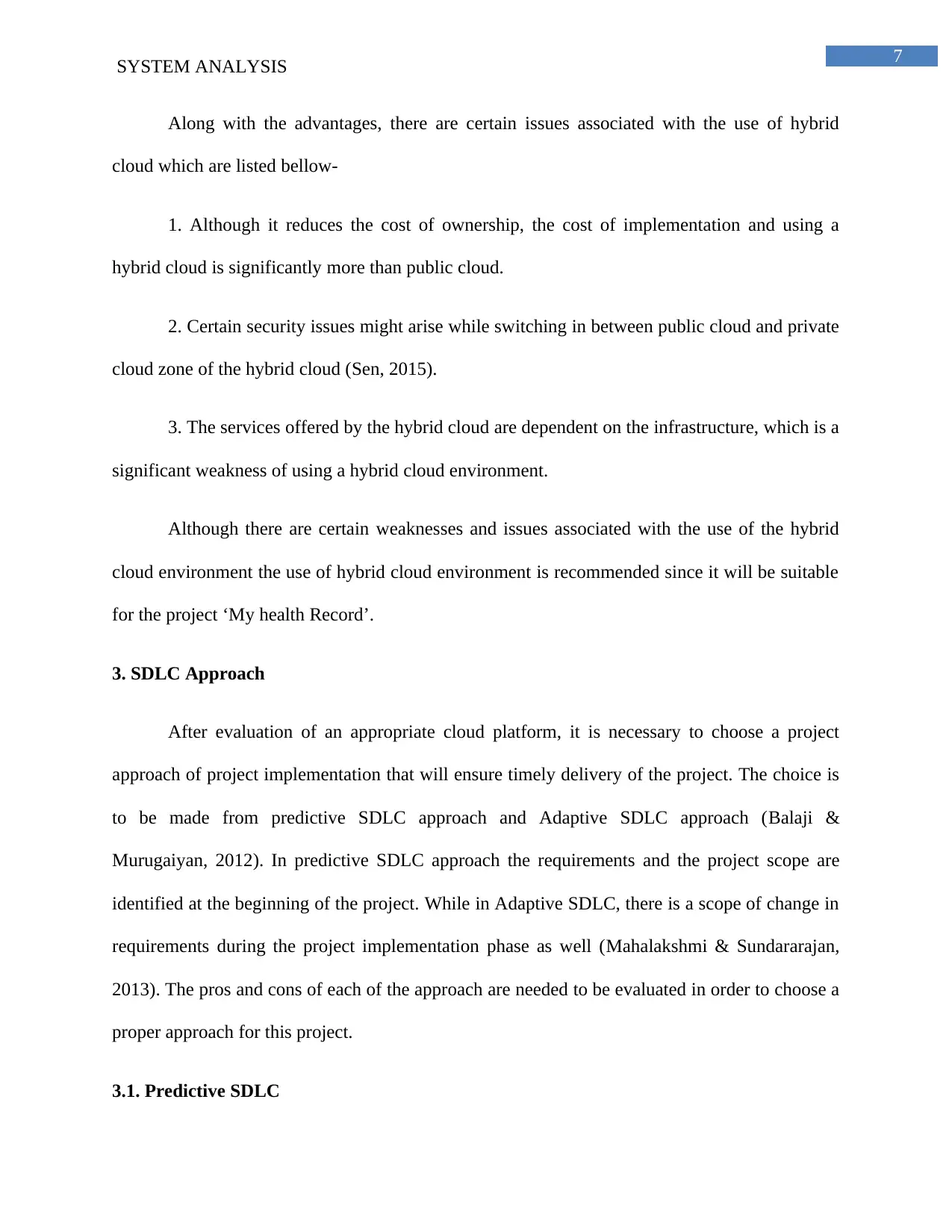
7
SYSTEM ANALYSIS
Along with the advantages, there are certain issues associated with the use of hybrid
cloud which are listed bellow-
1. Although it reduces the cost of ownership, the cost of implementation and using a
hybrid cloud is significantly more than public cloud.
2. Certain security issues might arise while switching in between public cloud and private
cloud zone of the hybrid cloud (Sen, 2015).
3. The services offered by the hybrid cloud are dependent on the infrastructure, which is a
significant weakness of using a hybrid cloud environment.
Although there are certain weaknesses and issues associated with the use of the hybrid
cloud environment the use of hybrid cloud environment is recommended since it will be suitable
for the project ‘My health Record’.
3. SDLC Approach
After evaluation of an appropriate cloud platform, it is necessary to choose a project
approach of project implementation that will ensure timely delivery of the project. The choice is
to be made from predictive SDLC approach and Adaptive SDLC approach (Balaji &
Murugaiyan, 2012). In predictive SDLC approach the requirements and the project scope are
identified at the beginning of the project. While in Adaptive SDLC, there is a scope of change in
requirements during the project implementation phase as well (Mahalakshmi & Sundararajan,
2013). The pros and cons of each of the approach are needed to be evaluated in order to choose a
proper approach for this project.
3.1. Predictive SDLC
SYSTEM ANALYSIS
Along with the advantages, there are certain issues associated with the use of hybrid
cloud which are listed bellow-
1. Although it reduces the cost of ownership, the cost of implementation and using a
hybrid cloud is significantly more than public cloud.
2. Certain security issues might arise while switching in between public cloud and private
cloud zone of the hybrid cloud (Sen, 2015).
3. The services offered by the hybrid cloud are dependent on the infrastructure, which is a
significant weakness of using a hybrid cloud environment.
Although there are certain weaknesses and issues associated with the use of the hybrid
cloud environment the use of hybrid cloud environment is recommended since it will be suitable
for the project ‘My health Record’.
3. SDLC Approach
After evaluation of an appropriate cloud platform, it is necessary to choose a project
approach of project implementation that will ensure timely delivery of the project. The choice is
to be made from predictive SDLC approach and Adaptive SDLC approach (Balaji &
Murugaiyan, 2012). In predictive SDLC approach the requirements and the project scope are
identified at the beginning of the project. While in Adaptive SDLC, there is a scope of change in
requirements during the project implementation phase as well (Mahalakshmi & Sundararajan,
2013). The pros and cons of each of the approach are needed to be evaluated in order to choose a
proper approach for this project.
3.1. Predictive SDLC
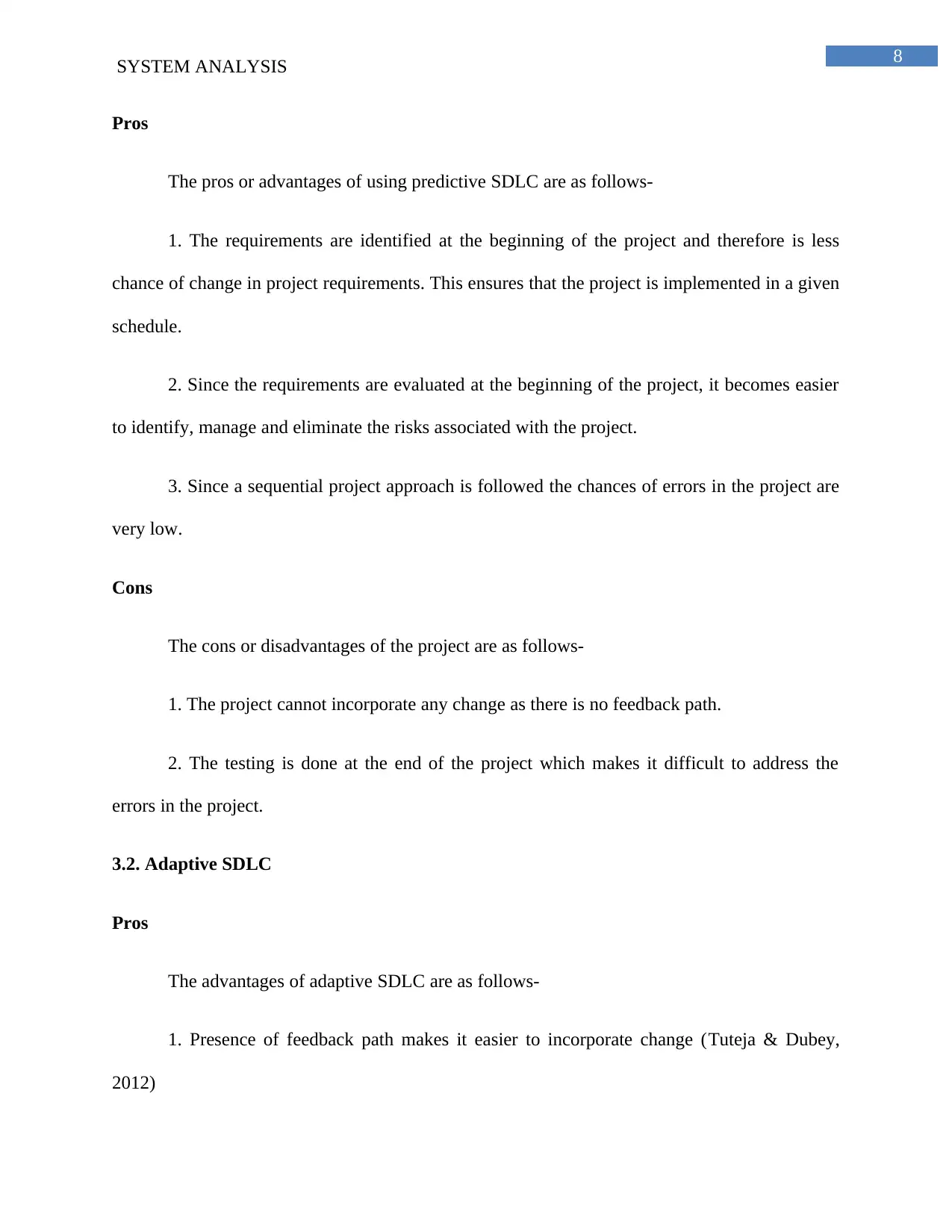
8
SYSTEM ANALYSIS
Pros
The pros or advantages of using predictive SDLC are as follows-
1. The requirements are identified at the beginning of the project and therefore is less
chance of change in project requirements. This ensures that the project is implemented in a given
schedule.
2. Since the requirements are evaluated at the beginning of the project, it becomes easier
to identify, manage and eliminate the risks associated with the project.
3. Since a sequential project approach is followed the chances of errors in the project are
very low.
Cons
The cons or disadvantages of the project are as follows-
1. The project cannot incorporate any change as there is no feedback path.
2. The testing is done at the end of the project which makes it difficult to address the
errors in the project.
3.2. Adaptive SDLC
Pros
The advantages of adaptive SDLC are as follows-
1. Presence of feedback path makes it easier to incorporate change (Tuteja & Dubey,
2012)
SYSTEM ANALYSIS
Pros
The pros or advantages of using predictive SDLC are as follows-
1. The requirements are identified at the beginning of the project and therefore is less
chance of change in project requirements. This ensures that the project is implemented in a given
schedule.
2. Since the requirements are evaluated at the beginning of the project, it becomes easier
to identify, manage and eliminate the risks associated with the project.
3. Since a sequential project approach is followed the chances of errors in the project are
very low.
Cons
The cons or disadvantages of the project are as follows-
1. The project cannot incorporate any change as there is no feedback path.
2. The testing is done at the end of the project which makes it difficult to address the
errors in the project.
3.2. Adaptive SDLC
Pros
The advantages of adaptive SDLC are as follows-
1. Presence of feedback path makes it easier to incorporate change (Tuteja & Dubey,
2012)
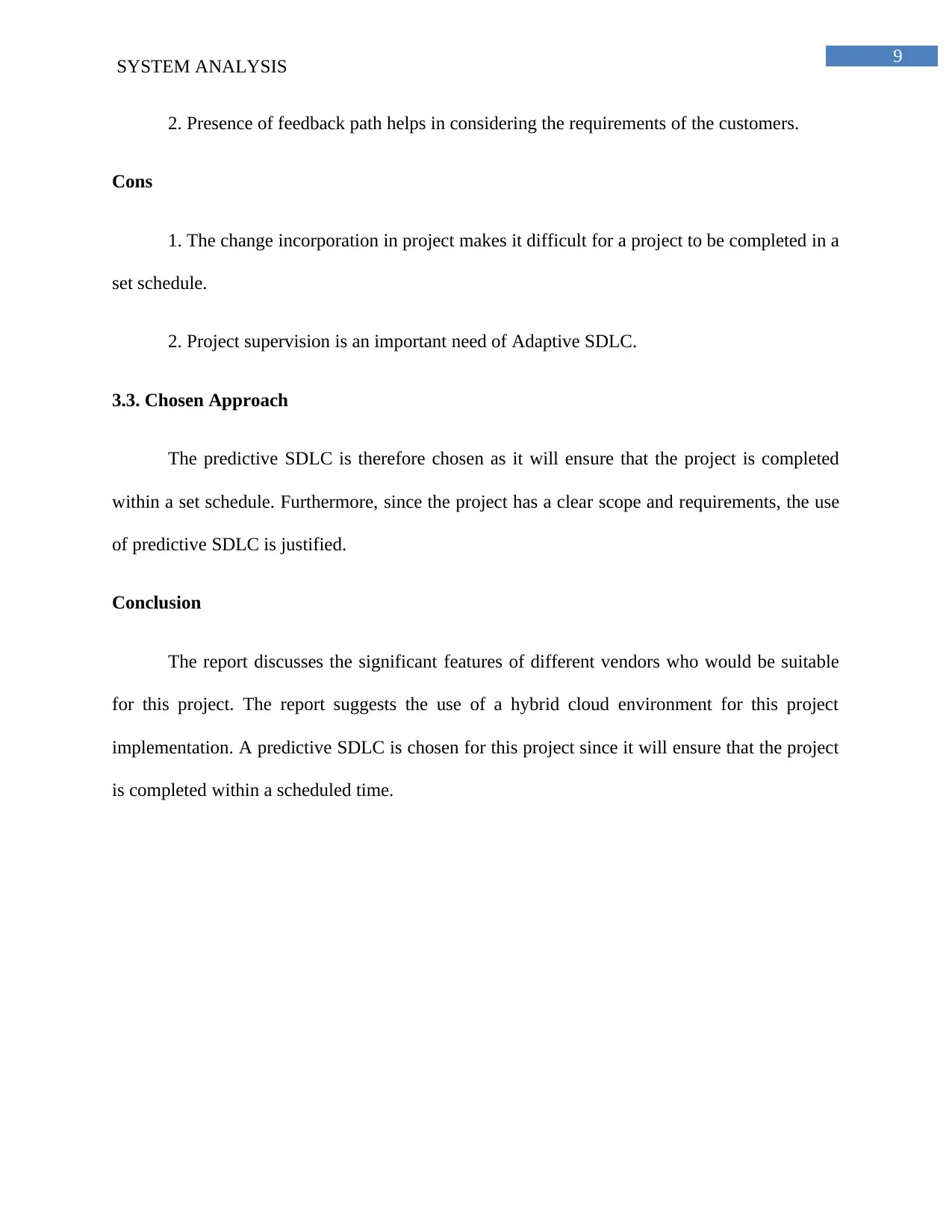
9
SYSTEM ANALYSIS
2. Presence of feedback path helps in considering the requirements of the customers.
Cons
1. The change incorporation in project makes it difficult for a project to be completed in a
set schedule.
2. Project supervision is an important need of Adaptive SDLC.
3.3. Chosen Approach
The predictive SDLC is therefore chosen as it will ensure that the project is completed
within a set schedule. Furthermore, since the project has a clear scope and requirements, the use
of predictive SDLC is justified.
Conclusion
The report discusses the significant features of different vendors who would be suitable
for this project. The report suggests the use of a hybrid cloud environment for this project
implementation. A predictive SDLC is chosen for this project since it will ensure that the project
is completed within a scheduled time.
SYSTEM ANALYSIS
2. Presence of feedback path helps in considering the requirements of the customers.
Cons
1. The change incorporation in project makes it difficult for a project to be completed in a
set schedule.
2. Project supervision is an important need of Adaptive SDLC.
3.3. Chosen Approach
The predictive SDLC is therefore chosen as it will ensure that the project is completed
within a set schedule. Furthermore, since the project has a clear scope and requirements, the use
of predictive SDLC is justified.
Conclusion
The report discusses the significant features of different vendors who would be suitable
for this project. The report suggests the use of a hybrid cloud environment for this project
implementation. A predictive SDLC is chosen for this project since it will ensure that the project
is completed within a scheduled time.
Secure Best Marks with AI Grader
Need help grading? Try our AI Grader for instant feedback on your assignments.
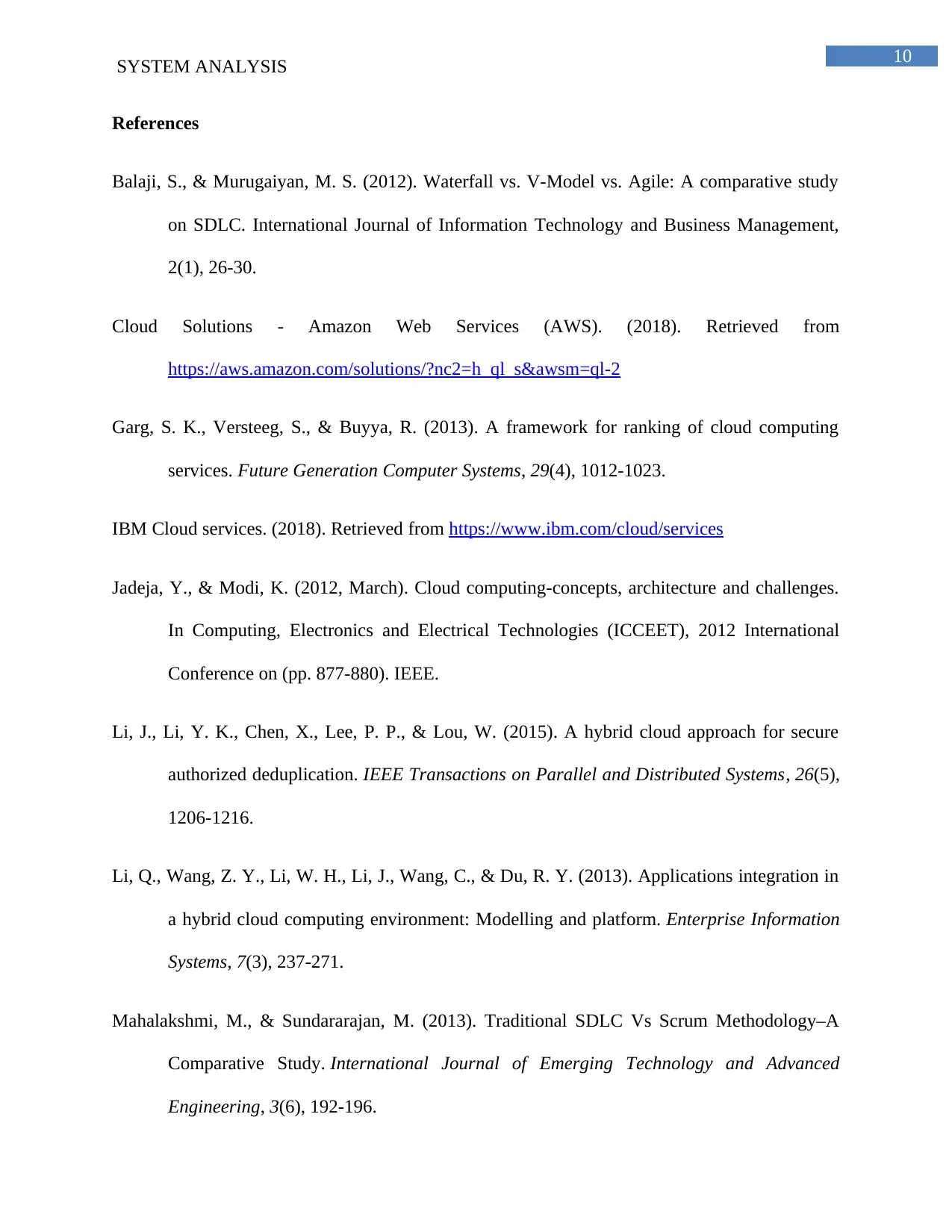
10
SYSTEM ANALYSIS
References
Balaji, S., & Murugaiyan, M. S. (2012). Waterfall vs. V-Model vs. Agile: A comparative study
on SDLC. International Journal of Information Technology and Business Management,
2(1), 26-30.
Cloud Solutions - Amazon Web Services (AWS). (2018). Retrieved from
https://aws.amazon.com/solutions/?nc2=h_ql_s&awsm=ql-2
Garg, S. K., Versteeg, S., & Buyya, R. (2013). A framework for ranking of cloud computing
services. Future Generation Computer Systems, 29(4), 1012-1023.
IBM Cloud services. (2018). Retrieved from https://www.ibm.com/cloud/services
Jadeja, Y., & Modi, K. (2012, March). Cloud computing-concepts, architecture and challenges.
In Computing, Electronics and Electrical Technologies (ICCEET), 2012 International
Conference on (pp. 877-880). IEEE.
Li, J., Li, Y. K., Chen, X., Lee, P. P., & Lou, W. (2015). A hybrid cloud approach for secure
authorized deduplication. IEEE Transactions on Parallel and Distributed Systems, 26(5),
1206-1216.
Li, Q., Wang, Z. Y., Li, W. H., Li, J., Wang, C., & Du, R. Y. (2013). Applications integration in
a hybrid cloud computing environment: Modelling and platform. Enterprise Information
Systems, 7(3), 237-271.
Mahalakshmi, M., & Sundararajan, M. (2013). Traditional SDLC Vs Scrum Methodology–A
Comparative Study. International Journal of Emerging Technology and Advanced
Engineering, 3(6), 192-196.
SYSTEM ANALYSIS
References
Balaji, S., & Murugaiyan, M. S. (2012). Waterfall vs. V-Model vs. Agile: A comparative study
on SDLC. International Journal of Information Technology and Business Management,
2(1), 26-30.
Cloud Solutions - Amazon Web Services (AWS). (2018). Retrieved from
https://aws.amazon.com/solutions/?nc2=h_ql_s&awsm=ql-2
Garg, S. K., Versteeg, S., & Buyya, R. (2013). A framework for ranking of cloud computing
services. Future Generation Computer Systems, 29(4), 1012-1023.
IBM Cloud services. (2018). Retrieved from https://www.ibm.com/cloud/services
Jadeja, Y., & Modi, K. (2012, March). Cloud computing-concepts, architecture and challenges.
In Computing, Electronics and Electrical Technologies (ICCEET), 2012 International
Conference on (pp. 877-880). IEEE.
Li, J., Li, Y. K., Chen, X., Lee, P. P., & Lou, W. (2015). A hybrid cloud approach for secure
authorized deduplication. IEEE Transactions on Parallel and Distributed Systems, 26(5),
1206-1216.
Li, Q., Wang, Z. Y., Li, W. H., Li, J., Wang, C., & Du, R. Y. (2013). Applications integration in
a hybrid cloud computing environment: Modelling and platform. Enterprise Information
Systems, 7(3), 237-271.
Mahalakshmi, M., & Sundararajan, M. (2013). Traditional SDLC Vs Scrum Methodology–A
Comparative Study. International Journal of Emerging Technology and Advanced
Engineering, 3(6), 192-196.
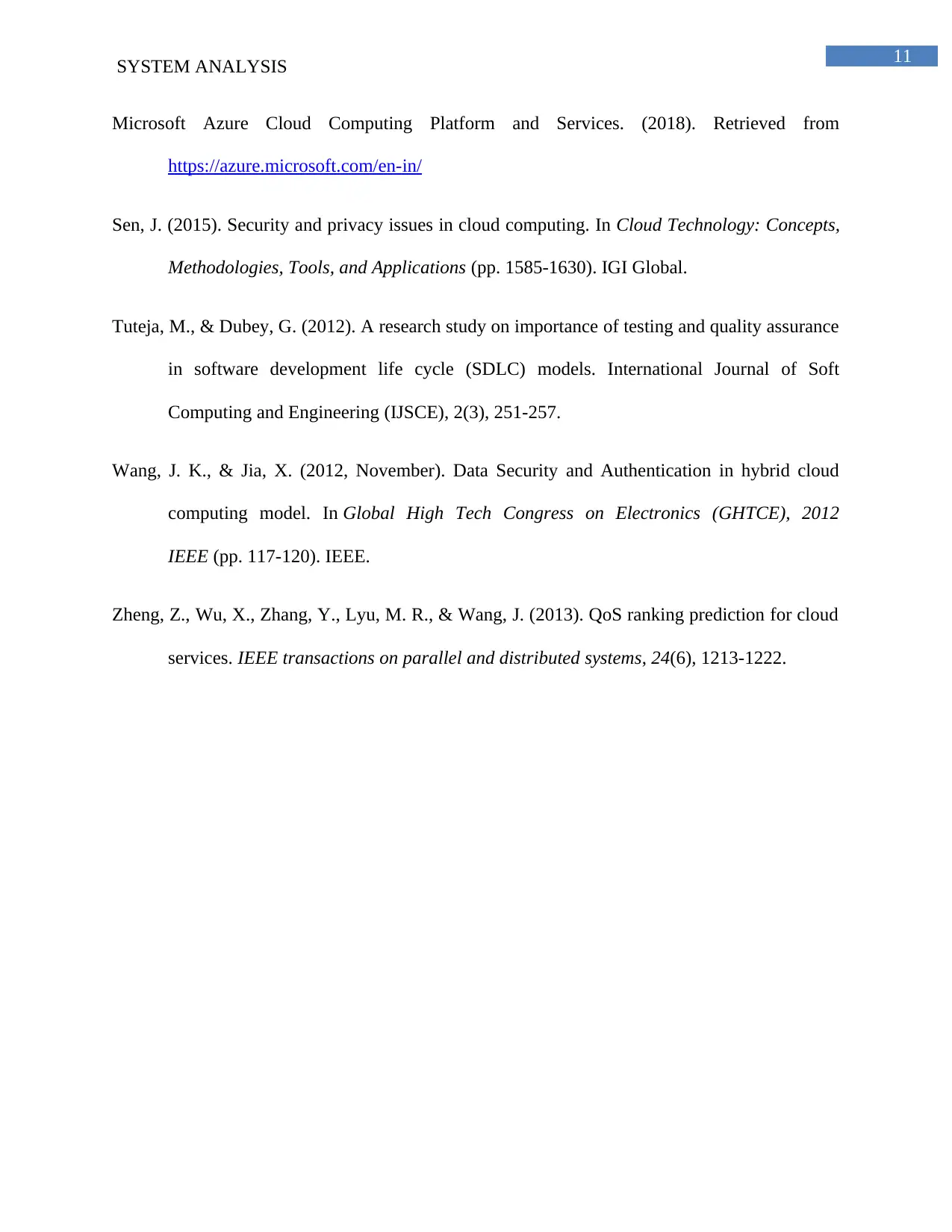
11
SYSTEM ANALYSIS
Microsoft Azure Cloud Computing Platform and Services. (2018). Retrieved from
https://azure.microsoft.com/en-in/
Sen, J. (2015). Security and privacy issues in cloud computing. In Cloud Technology: Concepts,
Methodologies, Tools, and Applications (pp. 1585-1630). IGI Global.
Tuteja, M., & Dubey, G. (2012). A research study on importance of testing and quality assurance
in software development life cycle (SDLC) models. International Journal of Soft
Computing and Engineering (IJSCE), 2(3), 251-257.
Wang, J. K., & Jia, X. (2012, November). Data Security and Authentication in hybrid cloud
computing model. In Global High Tech Congress on Electronics (GHTCE), 2012
IEEE (pp. 117-120). IEEE.
Zheng, Z., Wu, X., Zhang, Y., Lyu, M. R., & Wang, J. (2013). QoS ranking prediction for cloud
services. IEEE transactions on parallel and distributed systems, 24(6), 1213-1222.
SYSTEM ANALYSIS
Microsoft Azure Cloud Computing Platform and Services. (2018). Retrieved from
https://azure.microsoft.com/en-in/
Sen, J. (2015). Security and privacy issues in cloud computing. In Cloud Technology: Concepts,
Methodologies, Tools, and Applications (pp. 1585-1630). IGI Global.
Tuteja, M., & Dubey, G. (2012). A research study on importance of testing and quality assurance
in software development life cycle (SDLC) models. International Journal of Soft
Computing and Engineering (IJSCE), 2(3), 251-257.
Wang, J. K., & Jia, X. (2012, November). Data Security and Authentication in hybrid cloud
computing model. In Global High Tech Congress on Electronics (GHTCE), 2012
IEEE (pp. 117-120). IEEE.
Zheng, Z., Wu, X., Zhang, Y., Lyu, M. R., & Wang, J. (2013). QoS ranking prediction for cloud
services. IEEE transactions on parallel and distributed systems, 24(6), 1213-1222.
1 out of 12
Related Documents
Your All-in-One AI-Powered Toolkit for Academic Success.
+13062052269
info@desklib.com
Available 24*7 on WhatsApp / Email
![[object Object]](/_next/static/media/star-bottom.7253800d.svg)
Unlock your academic potential
© 2024 | Zucol Services PVT LTD | All rights reserved.



